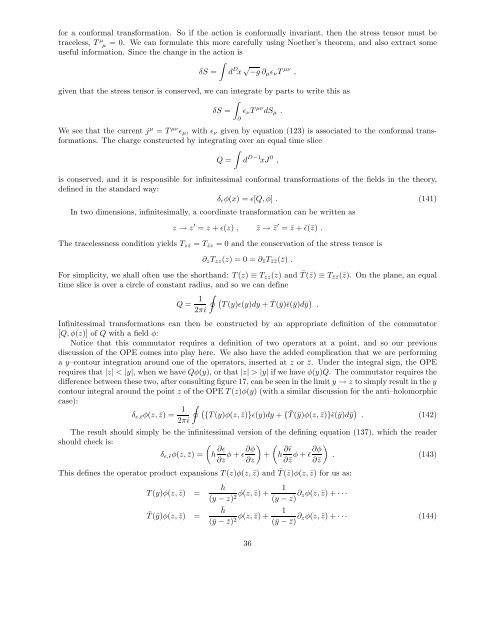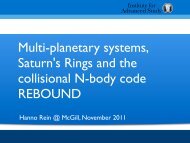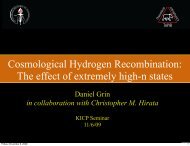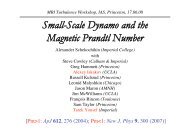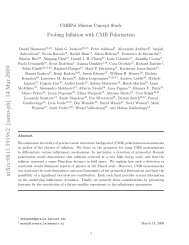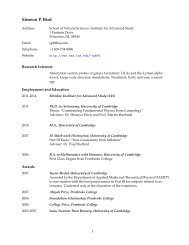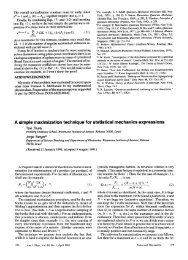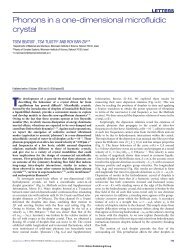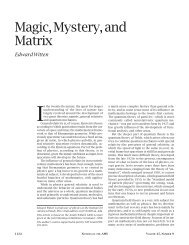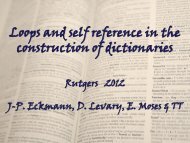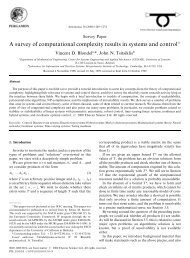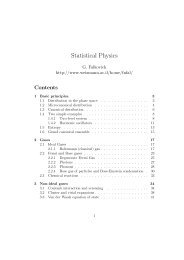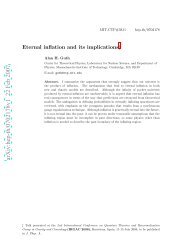Introduction to String Theory and D–Branes - School of Natural ...
Introduction to String Theory and D–Branes - School of Natural ...
Introduction to String Theory and D–Branes - School of Natural ...
Create successful ePaper yourself
Turn your PDF publications into a flip-book with our unique Google optimized e-Paper software.
for a conformal transformation. So if the action is conformally invariant, then the stress tensor must be<br />
traceless, T µ µ = 0. We can formulate this more carefully using Noether’s theorem, <strong>and</strong> also extract some<br />
useful information. Since the change in the action is<br />
<br />
δS =<br />
d D x √ −g ∂µɛνT µν ,<br />
given that the stress tensor is conserved, we can integrate by parts <strong>to</strong> write this as<br />
<br />
δS = ɛνT µν dSµ .<br />
∂<br />
We see that the current j µ = T µν ɛµ, with ɛν given by equation (123) is associated <strong>to</strong> the conformal trans-<br />
formations. The charge constructed by integrating over an equal time slice<br />
<br />
Q = d D−1 xJ 0 ,<br />
is conserved, <strong>and</strong> it is responsible for infinitessimal conformal transformations <strong>of</strong> the fields in the theory,<br />
defined in the st<strong>and</strong>ard way:<br />
δɛφ(x) = ɛ[Q, φ] . (141)<br />
In two dimensions, infinitesimally, a coordinate transformation can be written as<br />
z → z ′ = z + ɛ(z) , ¯z → ¯z ′ = ¯z + ¯ɛ(¯z) .<br />
The tracelessness condition yields Tz¯z = T¯zz = 0 <strong>and</strong> the conservation <strong>of</strong> the stress tensor is<br />
∂zTzz(z) = 0 = ∂¯zT¯z¯z(¯z) .<br />
For simplicity, we shall <strong>of</strong>ten use the shorth<strong>and</strong>: T(z) ≡ Tzz(z) <strong>and</strong> ¯ T(¯z) ≡ T¯z¯z(¯z). On the plane, an equal<br />
time slice is over a circle <strong>of</strong> constant radius, <strong>and</strong> so we can define<br />
Q = 1<br />
<br />
T(y)ɛ(y)dy <br />
+ T(¯y)¯ɛ(¯y)d¯y ¯ .<br />
2πi<br />
Infinitessimal transformations can then be constructed by an appropriate definition <strong>of</strong> the commuta<strong>to</strong>r<br />
[Q, φ(z)] <strong>of</strong> Q with a field φ:<br />
Notice that this commuta<strong>to</strong>r requires a definition <strong>of</strong> two opera<strong>to</strong>rs at a point, <strong>and</strong> so our previous<br />
discussion <strong>of</strong> the OPE comes in<strong>to</strong> play here. We also have the added complication that we are performing<br />
a y–con<strong>to</strong>ur integration around one <strong>of</strong> the opera<strong>to</strong>rs, inserted at z or ¯z. Under the integral sign, the OPE<br />
requires that |z| < |y|, when we have Qφ(y), or that |z| > |y| if we have φ(y)Q. The commuta<strong>to</strong>r requires the<br />
difference between these two, after consulting figure 17, can be seen in the limit y → z <strong>to</strong> simply result in the y<br />
con<strong>to</strong>ur integral around the point z <strong>of</strong> the OPE T(z)φ(y) (with a similar discussion for the anti–holomorphic<br />
case):<br />
δɛ,¯ɛφ(z, ¯z) = 1<br />
<br />
{T(y)φ(z, <br />
¯z)}ɛ(y)dy + { T(¯y)φ(z, ¯ ¯z)}¯ɛ(¯y)d¯y . (142)<br />
2πi<br />
The result should simply be the infinitessimal version <strong>of</strong> the defining equation (137), which the reader<br />
should check is:<br />
<br />
δɛ,¯ɛφ(z, ¯z) = h ∂ɛ<br />
<br />
φ + ɛ∂φ + h<br />
∂z ∂z<br />
∂¯ɛ<br />
<br />
φ + ¯ɛ∂φ .<br />
∂¯z ∂¯z<br />
(143)<br />
This defines the opera<strong>to</strong>r product expansions T(z)φ(z, ¯z) <strong>and</strong> ¯ T(¯z)φ(z, ¯z) for us as:<br />
T(y)φ(z, ¯z) =<br />
¯T(¯y)φ(z, ¯z) =<br />
h<br />
1<br />
(y − z) 2φ(z, ¯z) +<br />
(y − z) ∂zφ(z, ¯z) + · · ·<br />
¯h<br />
1<br />
φ(z, ¯z) +<br />
(¯y − ¯z) 2 (¯y − ¯z) ∂zφ(z, ¯z) + · · · (144)<br />
36


